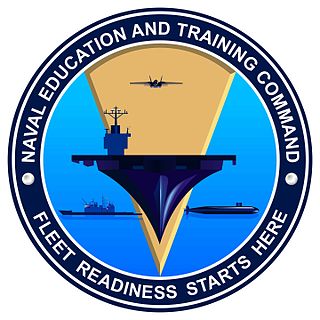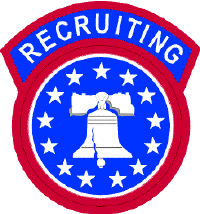
The United States Navy Reserve (USNR), known as the United States Naval Reserve from 1915 to 2005, is the Reserve Component (RC) of the United States Navy. Members of the Navy Reserve, called Reservists, are categorized as being in either the Selected Reserve (SELRES), the Training and Administration of the Reserve (TAR), the Individual Ready Reserve (IRR), or the Retired Reserve.

The Naval Education and Training Command (NETC) is an enterprise-level shore command of the United States Navy with more than 19,000 military and staff personnel at more than 1,640 subordinate activities, sites, districts, stations, and detachments throughout the world, and was established in 1971. NETC recruits, trains and delivers those who serve the nation, taking them from "street to fleet" by transforming civilians into highly skilled, operational, and combat ready warfighters.
The "bureau system" of the United States Navy was the Department of the Navy's material-support organization from 1842 through 1966. The bureau chiefs were largely autonomous, reporting directly to the Secretary of the Navy and managing their respective organizations without the influence of other bureaus. In 1966, the bureaus were gradually replaced by unified commands reporting to the Chief of Naval Operations.

RAAF Base Wagga is a Royal Australian Air Force (RAAF) military air base located 11 kilometres (6.8 mi) south-east of Wagga Wagga, in the suburb of Forest Hill, New South Wales, Australia.

Fleet Band Activities (FBA), formerly the Navy Music Program (NMP), is the central management office for nine active-duty fleet bands of the United States Navy. It is located at Naval Support Activity Mid-South in Millington, Tennessee. FBA has the responsibility of coordinating the assignment and distribution of personnel, equipment and funding to the worldwide activities of navy military bands. It also is responsible for managing the application and audition process for potential navy musicians. Personnel from the FBA work directly with the Bureau of Naval Personnel to meet our musician requirements for the fleet.

Armed Forces Entertainment (A.F.E) is the official United States Department of Defense (D.o.D) agency for providing entertainment to U.S. military personnel overseas. Armed Forces Entertainment hosts over 1,200 shows around the world each year, reaching over 500,000 personnel at 355 military installations. Types of talent include musicians, comedians, cheerleaders, and celebrities of sports, movies and television.
Citizen Corps is a program under the Department of Homeland Security that provides training for the population of the United States to assist in the recovery after a disaster or terrorist attack. Each local Citizen Corps Council partners with organizations, volunteers and businesses to organize responders, volunteers and professional first responders for an efficient response so efforts are not wasted by being duplicated. By training in Incident Command, volunteers know whom to report to and how the incident is organized. This prevents sites from being inundated by untrained and unprepared personnel preventing operation. Citizen Corps also works in conjunction with the Corporation for National and Community Service in promoting national service opportunities for promoting homeland security needs.
Auxiliary constables or reserve constables are unpaid citizens in Canada who volunteer their time and skills to a police force. They are uniformed, unarmed members who perform a similar role to their UK counterparts in the Special Constabulary. Their main function is to supplement the police force with additional manpower, with duties varying by appointment, geographical location and the needs of the specific detachment/department.

Aviation Maintenance Administrationman (AZ) is a United States Navy occupational rating.

Mass Communication Specialist is a United States Navy public affairs type rating. MCs practice human-centered design to develop creative communication solutions and align communication strategies and tactics to leadership's intent; conduct research and develop audience profiles; prepare, process, and print publications and media products; create sketches, storyboards, and graphics; design publications; produce still imagery, and written, audio, video, and multimedia information products; collect, analyze, and report media project and communication plan feedback and performance information; create media project plans; conduct community outreach, news media operations, leadership communication operations, and organizational communication operations; plan and direct communication campaigns and events and serve as communication advisors to commanders; and develop content strategies, create data stories, and ensure communication products and experiences are designed to enhance understanding and discoverability. MCs serve aboard ships, in expeditionary units and at shore commands in the United States and overseas.

Religious Program Specialist (RP) is a designated rating within the United States Navy. As an essential member of Professional Naval Chaplaincy, RPs fulfill a crucial function in administering religious ministry within the Department of the Navy (DON). Together with chaplains, they form the Religious Ministry Team (RMT). In this capacity, RPs actively support the provision and facilitation of Religious Ministry, offering assistance and care to Navy and Marine Corps personnel, as well as their families, irrespective of their backgrounds and faith affiliations. Despite working in a religiously diverse environment, RPs are not mandated to hold religious beliefs nor perform pastoral counseling for the service members under their care. Due to the mobile nature of the units they may be assigned to, RPs can be stationed on Navy ships, at various Navy and Marine Corps commands, navy construction battalions, and other unique combatant units-rendering them globally deployable.
In the United States, the hospital incident command system (HICS) is an incident command system (ICS) designed for hospitals and intended for use in both emergency and non-emergency situations. It provides hospitals of all sizes with tools needed to advance their emergency preparedness and response capability—both individually and as members of the broader response community.

Civil Air Patrol (CAP) is a congressionally chartered, federally supported non-profit corporation that serves as the official civilian auxiliary of the United States Air Force (USAF). CAP is a volunteer organization with an aviation-minded membership that includes members from all backgrounds. The program is established as an organization by Title 10 of the United States Code and its purposes defined by Title 36.

Navy Weeks are designed to educate Americans on the importance of Naval service, understand the investment they make in their Navy and to increase awareness in cities which might not otherwise see the Navy at work on a regular basis.

The United States Army Recruiting Command is responsible for manning both the United States Army and the Army Reserve. Recruiting operations are conducted throughout the United States, U.S. territories, and at U.S. military facilities in Europe, Asia, and the Middle East. This process includes the recruiting, medical and psychological examination, induction, and administrative processing of potential service personnel.

Naval Support Activity Mid-South, in Millington, Tennessee, is a base of the United States Navy. A part of the Navy Region Southeast and the Navy Installations Command, NSA Mid-South serves as the Navy’s Human Resources Center of Excellence. The base is host to several commands and other military tenants: Navy Personnel Command, Navy Recruiting Command, the Navy Manpower Analysis Center, a Marine Corps Reserve Company - Bridge Company C and the US Army Corps of Engineers Finance Center. More than 7,500 military, civilian, and contract personnel are assigned/work on base.
All Partners Access Network (APAN), formerly called Asia-Pacific Area Network, is a United States Department of Defense (USDOD) social networking website used for information sharing and collaboration. APAN is the premier collaboration enterprise for the USDOD. The APAN network of communities fosters multinational interaction and multilateral cooperation by allowing users to post multimedia and other content in blogs, wikis, forums, document libraries and media galleries. APAN is used for humanitarian assistance and disaster relief, exercise planning, conferences and work groups. APAN provides non-governmental organizations (NGOs) and U.S. partner nations who do not have access to traditional, closed USDOD networks with an unclassified tool to communicate.

The Pacific Fleet Band is a United States Navy military Band that is attached to the United States Pacific Fleet based at Naval Station Pearl Harbor. It performs at civilian/military ceremonies, military parades, and unit/community events. It operates under the direct control and supervision of Fleet Band Activities, the official navy music program. It is alsk under the operational control of the Commander in Chief, U.S. Pacific Fleet.
















